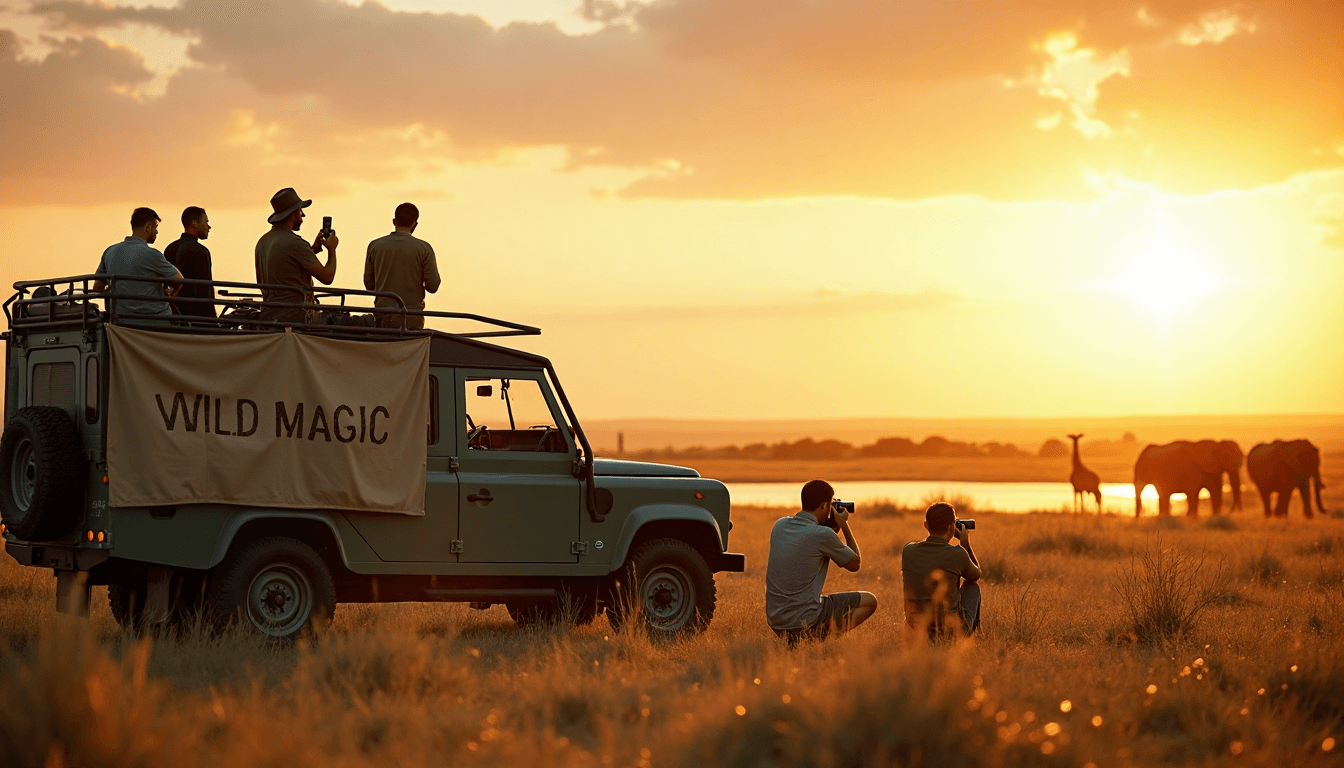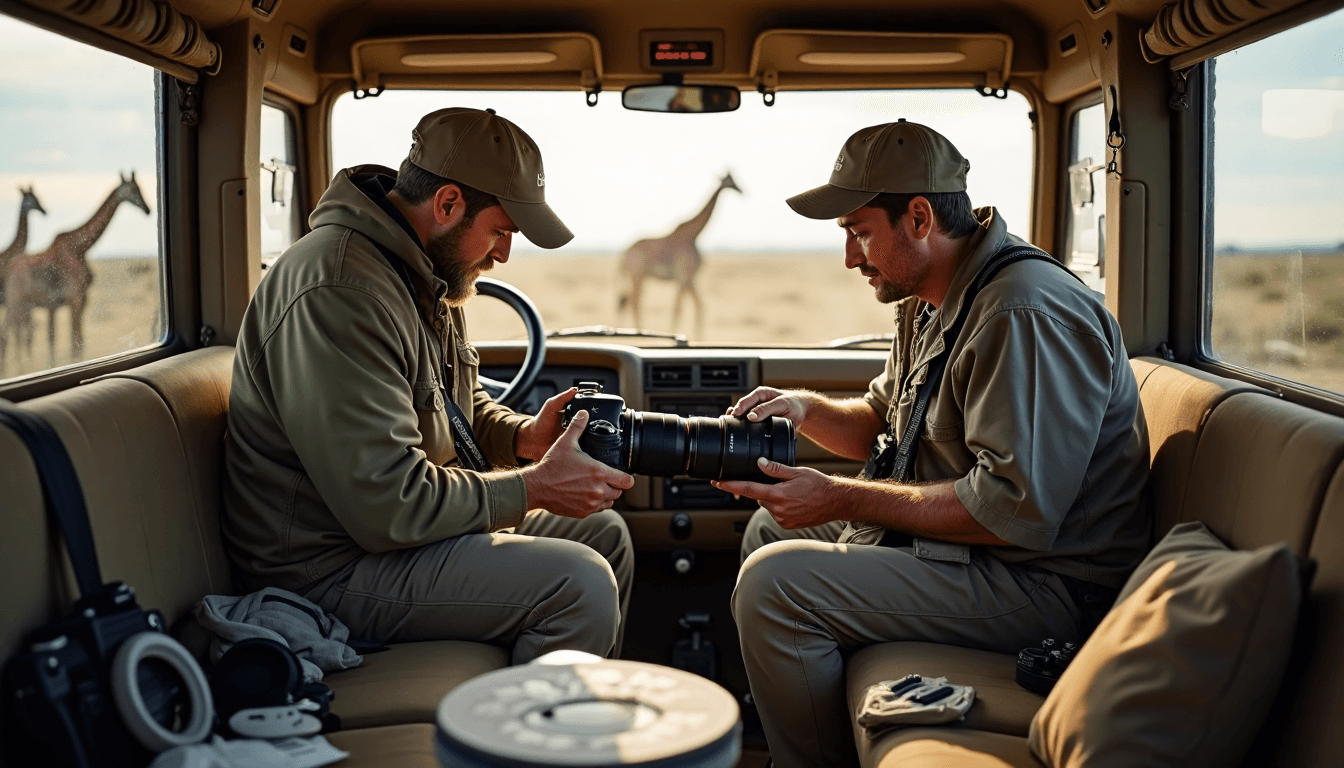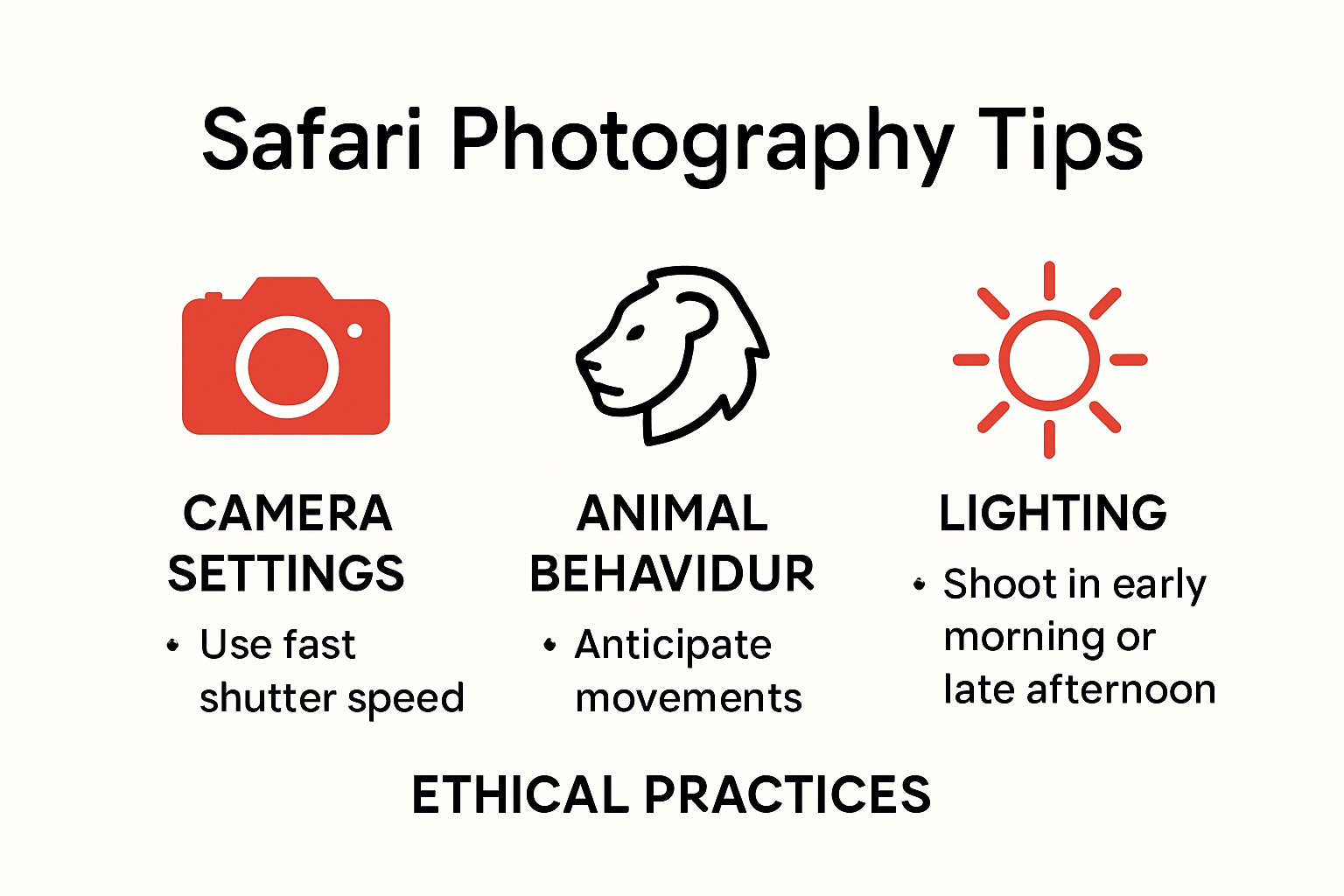Safari Photography Tips 2025: Capture Africa’s Wild Magic
Full Disclosure: Our AI Assistant Writes These!
While we're out in the bush tracking leopards, dodging elephants, and trying to get the perfect sunset shot, our trusty AI companion is back at camp, diligently crafting these blog posts. Don't worry though - it's been trained on years of real safari experiences and only occasionally suggests that tourists should pet the lions. (Please don't pet the lions. The AI was joking. We hope.)
The real reason? SEO loves fresh content, and we love fresh adventures. So while our AI handles the keywords and search rankings, we're out there finding the next hidden waterhole, secret viewpoint, or that one tree where the leopards always hang out. Win-win, really!
Safari Photography Tips 2025: Capture Africa’s Wild Magic

Safari photography is quickly becoming a favourite for South Africans who crave adventure behind the lens. Think about this: the dry season in Africa gathers more animals at waterholes, making it up to three times easier to spot and capture diverse wildlife in a single photo. Most people stress about getting the latest, fanciest camera. Funny thing is, knowing animal behaviour and timing your shot often matters more than having top gear. This is where safari photography truly surprises, letting creativity and patience trump even the biggest zoom lens.
Table of Contents
- Essential Gear For Stunning Safari Photos
- Best Techniques For Capturing Wildlife Moments
- Planning And Timing Your Safari Shots
- Unique Tips For Families And Solo Travellers
Quick Summary
| Takeaway | Explanation |
|---|---|
| Essential Gear is Crucial | Use professional-grade DSLR or mirrorless cameras with telephoto lenses (400mm minimum) and protective accessories to capture stunning wildlife photos in challenging conditions. |
| Understanding Animal Behavior | Observe and predict animal movements while ensuring a safe distance to capture authentic moments, particularly during optimal lighting conditions at dawn and dusk. |
| Planning Based on Seasons | Focus on the dry season (May to October) for improved visibility and animal congregation around water sources, enhancing photographic opportunities. |
| Family and Solo Strategies | When traveling with family, engage children with personal equipment and wildlife games; solo travelers should leverage flexibility and mobility for unique shots. |
Essential Gear for Stunning Safari Photos
Capturing the raw magic of African wildlife requires more than just a good eye. The right photography gear can transform your safari experience from ordinary snapshots to breathtaking visual stories that transport viewers into the heart of the wilderness.
Choosing the Right Camera Equipment
Wildlife photography demands specialized gear that can perform under challenging conditions. A professional-grade DSLR or mirrorless camera with robust weather sealing becomes your primary tool for documenting Africa’s incredible creatures. According to Australian Geographic, a telephoto lens with a focal length of at least 400mm is crucial for capturing distant wildlife without disturbing their natural habitat.
Key Camera Recommendations:
- Professional Camera Body: Weather-sealed with fast autofocus
- Telephoto Lens: 400mm minimum focal length
- Backup Battery System: Multiple batteries for extended shooting
The harsh safari environment presents unique challenges. Dust, intense sunlight, and rapid temperature changes can compromise equipment. Protective gear becomes as essential as the camera itself. A UV filter not only protects your lens from scratches but also improves image clarity by reducing ultraviolet light interference, as recommended by Outdoor Photo.

Here’s a table summarizing recommended camera equipment and accessories for safari photography to help you quickly compare their purposes:
| Item | Primary Purpose | Key Consideration |
|---|---|---|
| Professional Camera Body | Capture high-quality images, durable | Weather-sealed, fast autofocus |
| Telephoto Lens (≥400mm) | Photograph distant wildlife | Minimum 400mm focal length |
| Backup Battery System | Prolong shooting sessions | Multiple fully charged batteries |
| UV Filter | Protect lens & improve clarity | Blocks scratches & UV interference |
Stabilization and Mobility Accessories
Stability is critical when photographing wildlife from moving vehicles or challenging terrains. Professional photographers rely on specialized accessories to ensure sharp, crisp images. A small beanbag cushion provides unexpected but effective lens support during game drives, especially when using vehicle windows or rooftops. Exodus Travel highlights this technique as a game-changing approach for wildlife photographers.
Essential Stabilization Tools:
- Beanbag Cushion: Provides stable support for long lenses
- Monopod: Lightweight alternative to traditional tripods
- Image Stabilization Lenses: Compensate for vehicle movement
For those looking to plan their photographic safari adventure comprehensively, our comprehensive safari planning guide offers additional insights into preparing the right equipment.
Beyond technical specifications, successful safari photography requires understanding your gear intimately. Practice with your equipment before the trip. Familiarize yourself with quick settings adjustments, battery management, and lens changes. The African wilderness waits for no photographer - being prepared means being ready to capture those fleeting, extraordinary moments that tell powerful visual stories of nature’s incredible diversity.
Remember that while top-tier equipment significantly enhances your chances of stunning photographs, creativity, patience, and a deep respect for wildlife remain your most valuable assets in safari photography.
Best Techniques for Capturing Wildlife Moments

Photographing wildlife requires more than technical expertise. It demands patience, understanding of animal behavior, and a keen artistic eye that transforms fleeting moments into compelling visual narratives.
Understanding Animal Behavior and Light
Successful wildlife photography begins with observing and predicting animal movements. According to the United States Forest Service, maintaining a safe distance while using telephoto lenses allows photographers to capture authentic moments without disrupting natural behaviors. Early morning and late afternoon provide the most dramatic lighting conditions, creating rich golden hues that dramatically enhance wildlife images.
Critical Observation Techniques:
- Patient Positioning: Select strategic observation points
- Silent Movement: Minimize sudden sounds or movements
- Understand Habitat: Learn animal patterns and territories
Composition plays a crucial role in transforming good photographs into extraordinary visual stories. New Zealand Department of Conservation recommends employing the ‘rule of thirds’ - strategically placing subjects along grid lines or intersections to create balanced and engaging photographs.
Technical Strategies for Dynamic Shots
Capturing wildlife requires mastering technical settings quickly. Fast shutter speeds are essential for freezing motion, particularly during animal interactions or sudden movements. Professional photographers suggest using continuous autofocus modes and high-speed burst shooting to increase chances of capturing perfect moments.
Advanced Shooting Techniques:
- Burst Mode: Capture multiple frames per second
- High Shutter Speed: Minimize motion blur
- Adaptive ISO: Balance light and motion requirements
Our comprehensive safari planning guide provides additional insights into preparing for these photographic challenges.
Beyond technical skills, successful wildlife photography demands respect for the environment. Ethical photographers prioritize animal welfare, maintaining safe distances and never disrupting natural behaviors for a photograph. Each image should tell a story of coexistence, wonder, and the incredible diversity of African wildlife.
Remember that the most memorable wildlife photographs emerge from a combination of preparation, patience, and profound respect for the natural world. Your camera is not just a tool but a bridge connecting viewers with the untamed beauty of Africa’s wilderness.
Planning and Timing Your Safari Shots
Successful safari photography transcends technical skills and equipment. Strategic planning and understanding the nuanced rhythms of wildlife become the cornerstone of capturing extraordinary moments that tell compelling visual stories.
Seasonal Considerations and Wildlife Patterns
Timing is everything in wildlife photography. According to Ranger Buck Safaris, the dry season between May and October offers photographers optimal conditions for capturing wildlife. During these months, thinner vegetation and animals congregating around limited water sources create unprecedented opportunities for remarkable shots.
Strategic Seasonal Planning:
- Dry Season: Enhanced wildlife visibility
- Water Source Concentration: Increased animal interactions
- Reduced Vegetation: Clearer photographic backgrounds
Paolo Sartori Photography emphasizes the significance of ‘golden hours’ golden hours during early morning and late afternoon. These timeframes provide soft, directional light that dramatically enhances image quality, creating rich textures and eliminating harsh midday shadows.
To help you plan your shots, here’s a table summarizing key seasonal considerations and optimal timing for safari photography:
| Aspect | Details/Timeframe | Benefit for Photography |
|---|---|---|
| Dry Season | May – October | More animal visibility at waterholes |
| Golden Hours | Early morning, late afternoon | Softer light, richer colours |
| Reduced Vegetation | Dry season | Clear backgrounds, fewer obstructions |
| Water Source Gathering | During dry months | Higher animal concentration |
Anticipating Wildlife Behavior
Understanding animal behavior transforms random snapshots into narrative photographs. Arrow Adventures highlights that patience and observation are more crucial than expensive equipment. Wildlife doesn’t follow scripts predictable patterns require deep ecological knowledge.
Behavioral Photography Strategies:
- Research Local Species: Understand migration and feeding patterns
- Learn Territorial Behaviors: Predict potential interaction zones
- Observe Subtle Movement Cues: Anticipate potential action moments
Our comprehensive safari planning guide offers additional insights into preparing for these photographic challenges.
Successful safari photography demands more than technical proficiency. It requires a profound respect for wildlife, an understanding of ecological systems, and the patience to wait for those transformative moments that reveal the raw beauty of nature. Your photographs become more than images they are windows into the intricate dance of survival and coexistence that defines African wilderness.
Remember that every great wildlife photograph tells a story. Your role is not just to capture an image but to document a moment of connection between human perspective and the untamed spirit of the natural world.
Unique Tips for Families and Solo Travellers
Safari photography is a transformative experience that offers distinct challenges and opportunities for families and solo travelers. Each group requires tailored strategies to maximize their photographic journey while ensuring memorable and engaging wildlife encounters.
Family Safari Photography Strategies
Lonely Planet recommends empowering children by providing them with their own equipment to enhance engagement. Equipping each child with personal binoculars and wildlife identification books transforms the safari from a passive experience into an interactive learning adventure.
Family Photography Engagement Techniques:
- Personal Equipment: Give children their own binoculars
- Learning Tools: Provide wildlife identification books
- Interactive Documentation: Encourage personal photography and sketching
National Geographic suggests turning wildlife observation into an exciting game. Create animal spotting checklists and reward systems that maintain children’s interest during potentially long periods of waiting. This approach teaches patience while maintaining enthusiasm for wildlife photography.
Solo Traveler Photography Approaches
Solo travelers have unique advantages in wildlife photography. Increased mobility and flexibility allow for more spontaneous and intimate photographic opportunities. Our budget solo travel guide provides insights into maximizing these advantages.
Solo Traveler Photography Advantages:
- Flexible Scheduling: Adapt quickly to wildlife movements
- Personal Pace: Set individual photography rhythms
- Focused Observation: Minimize group distractions
For solo photographers, joining small guided tours can provide safety, local expertise, and shared knowledge. These groups offer opportunities to learn from experienced guides while maintaining individual creative freedom.
Regardless of travel style, successful safari photography demands a universal approach: respect for wildlife, patience, and a genuine sense of wonder. Families can create shared memories, while solo travelers can pursue deeply personal visual narratives.
Each safari photograph is more than an image. It is a story of connection between human observation and the wild. Whether traveling with family or solo, your camera becomes a bridge to understanding the profound beauty and complexity of African wildlife.
Frequently Asked Questions
What camera gear is essential for safari photography?
A professional-grade DSLR or mirrorless camera with a minimum 400mm telephoto lens is crucial, along with protective accessories like UV filters and multiple backup batteries.
When is the best time for safari photography in Africa?
The dry season, from May to October, is optimal for safari photography, as animals congregate near waterholes, enhancing visibility and photographic opportunities.
What techniques should I use to capture wildlife moments?
Observing animal behavior, using fast shutter speeds, and employing techniques like burst mode and continuous autofocus can help capture dynamic wildlife moments effectively.
How can families engage children in safari photography?
Provide children with their own equipment like binoculars, encourage them to keep wildlife identification books, and turn observations into interactive games to maintain their interest during the safari.
Transform Your Safari Photos Into Lifelong Memories With Africa Awesome
Struggling to turn those once-in-a-lifetime wildlife encounters into powerful photographs? The article above highlights how many photographers on safari feel limited by their gear or unsure about capturing animals in their finest moments. You may worry about missing that perfect shot during the golden hour, choosing the wrong equipment, or not catching the true spirit of Africa’s iconic parks. These challenges are real, but your personal safari story deserves to stand out.

Let Africa Awesome take your journey beyond the ordinary. Explore our expert safari packages and get personalised planning that makes every moment photograph-worthy. Chat live with travel specialists who can help you pick the right time, place, and gear, ensuring your next safari is both stress-free and unforgettable. Your adventure starts sooner than you think. Start planning now by visiting Africa Awesome and move one step closer to capturing Africa’s wildest magic.